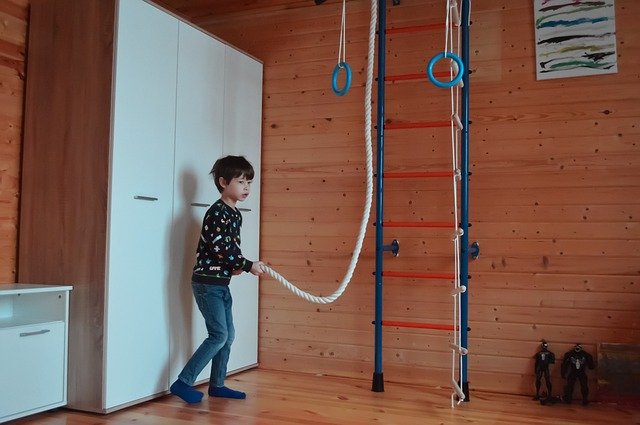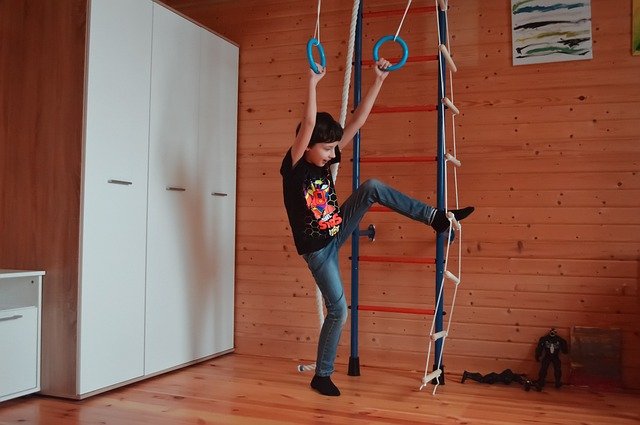Understanding the Risks: Weight Training vs. Strength Training for Prepubescent Children
Explore the potential downsides of weight training for prepubescent children and learn the differences between weight and strength training to make informed decisions for young athletes.
While physical activity is essential for kids, it’s crucial to understand that not all forms of exercise are suitable for their developing bodies. Weight training, for instance, might not be the best fit for youngsters who have yet to hit puberty. Let’s delve into why strength training can be adapted to better suit their needs, ensuring their safety and well-being.
– Coach Johnny

Support the JK Tribe with a Johnny’s Kidz, The Game Belongs to Them T-Shirt

PAPERAGE Blank Journal Notebook, (Black), 160 Pages, Medium 5.7 inches x 8 inches – 100 gsm Thick Paper, Hardcover
Introduction: The Importance of Age-Appropriate Exercise
Physical activity is not just a part of healthy living for children; it is a cornerstone of their growth and development, helping them build sturdy bones, improve cardiovascular health, and boost mental well-being.
However, when it comes to structured exercise routines like weight training, we must carefully consider what is appropriate for children at various ages and stages of development.
For prepubescent children, the structure of their bodies and the sensitivity of their developing systems make some forms of exercise more suitable than others.
It is important to grasp the differences between weight training and strength training.
This knowledge empowers parents and coaches to make informed decisions about the most suitable exercise for children, which can significantly impact their health and physical growth.
Weight training, often associated with lifting heavy weights to build muscle mass and strength, might not be ideal for younger children due to their growing bones and joints.
On the other hand, strength training can be safely tailored to suit younger bodies, generally by a trained, licensed professional.
It focuses on lighter weights and higher repetitions to enhance muscle control and overall fitness without the same risks.
This adaptability should give parents and coaches confidence in its suitability for children.
It’s about protecting children from potential injuries and laying a foundation for lifelong fitness habits.

“Strength training programs for preadolescents and adolescents can be safe and effective if proper techniques and safety precautions are followed.”
– American Academy of Pediatrics
What is Weight Training?
Weight training is a form of exercise that uses weights to enhance muscle strength and increase muscle size.
This type of training is commonly practiced using free weights such as dumbbells, kettlebells, and barbells, as well as machines that create resistance.
However, weight training carries different implications and potential risks for younger, prepubescent children.
Their bodies are still in the early stages of growth and development, so their muscles, bones, and connective tissues are not fully matured.
Lifting heavy weights can put undue stress on these developing structures, leading to injuries or adverse effects on bone health and growth patterns.
Therefore, while weight training can be beneficial in certain contexts, it is crucial to approach it with caution and proper guidance when considering it for children who have not yet reached puberty.
The key is to ensure that any training regimen is suited to their current level of physical development and long-term health goals.
The Downside of Weight Training for Prepubescents
- Risk of Injuries – A primary concern with weight training for prepubescent children is the heightened risk of injuries. This is especially true for sensitive areas like the spine and growth plates, critical to their growth and overall health.
- Potential for Growth Disturbances – While the evidence is not entirely definitive, and moderate weight training under careful supervision might be deemed safe, the potential for growth disturbances must be addressed.
- Overemphasis on Physical Appearance Starting weight training too early can also lead to an unhealthy emphasis on physical appearance and body image, which might not be psychologically beneficial for young children. For young athletes, cultivating a love for movement and sportsmanship is far more important than pursuing an idealized physique.
“Youth resistance training should be part of a broader physical conditioning framework designed to promote sports performance, fitness, and health.”
– The National Strength and Conditioning Association

What is Strength Training?
Strength training takes a fundamentally different approach when tailored for children than traditional weight training geared towards adults.
Instead of focusing on heavy weights and increasing muscle size, pediatric strength training emphasizes enhancing muscle strength, endurance, and overall flexibility using safe and appropriate methods for young, developing bodies.
This type of training typically involves exercises that use the child’s body weight as resistance.
Examples of such exercises include push-ups, sit-ups, and various gymnastic moves.
These activities are excellent for building a foundational level of strength without overloading sensitive and growing muscles and joints.
Moreover, they help improve coordination and motor skills, which are crucial during the developmental years.
In addition to bodyweight exercises, light resistance training can be incorporated safely into a child’s regimen.
Children can use tools like resistance bands or light dumbbells to perform a range of controlled movements that help build muscle and bone strength.
These tools provide enough resistance to be challenging yet do not strain the body like heavier weights might.
The overarching goal of strength training for kids is not just about getting stronger.
It’s also about enhancing their physical literacy, which includes developing a broad range of physical skills and a positive attitude toward active living.
Strength training can contribute to holistic development, ensuring that children grow up strong and with a healthy relationship to exercise and physical activity.
The Benefits of Strength Training for Prepubescent Children
- Enhances Muscular Strength and Endurance: Strength training can significantly boost children’s muscle strength and endurance when tailored appropriately. This helps them perform better in various sports and supports their daily activities. Enhancing these capabilities ensures they are more capable and confident in their physical abilities.
- Promotes Healthy Bones: Engaging in activities that exert gentle but firm stress on bones is crucial during the early years as it helps stimulate bone growth and development. Strength training, through activities like jumping or lifting light weights, provides the right stress to promote bone density and overall bone health, setting a strong foundation for later years.
- Improves Coordination and Balance: Focusing on bodyweight exercises and light resistance training improves coordination and balance. These skills are fundamental not only to sports performance but also to everyday activities. By enhancing their coordination and balance, children are less likely to experience injuries and more likely to enjoy a range of physical activities, improving their overall physical development.
Guidelines for Safe Strength Training
- Supervision by Qualified Professionals: Children must be supervised by professionals specially trained in pediatric exercise science. This ensures that the exercises are performed safely and effectively, reducing the risk of injury and maximizing the benefits of the training.
- Focus on Technique Over Weight When introducing strength training to children, the primary emphasis should be mastering the correct form and technique rather than lifting heavier weights. Proper technique prevents injuries and effectively develops muscle strength and coordination.
- Gradual Progression Strength training for children should follow a gradual progression, starting with lower-intensity exercises and slowly increasing in difficulty as the child’s strength, endurance, and skills develop. This approach helps to ensure that the training is age-appropriate and aligns with their physical development, fostering long-term health and fitness.
Conclusion: Making the Right Choice for Child Athletes
While weight training may not be the most suitable form of exercise for prepubescent children due to its associated risks, strength training that is appropriately tailored to their developmental stage can be incredibly beneficial.
It is crucial for parents and coaches to consult with healthcare professionals and certified fitness experts to receive guidance that is specifically adapted to each child’s individual needs.
By prioritizing safe practices and recognizing the numerous benefits of strength training, we can help ensure that children enjoy a healthy, active, and fulfilling lifestyle.
This approach promotes physical well-being and instills a lifelong appreciation for fitness and activity.
FAQ
References
- American Academy of Pediatrics (AAP) – “Strength Training by Children and Adolescents”:
- This policy statement by the AAP outlines the safety and effectiveness of strength training for children and adolescents, emphasizing proper techniques and avoiding maximal lifts.
- Link: AAP Guidelines
- National Strength and Conditioning Association (NSCA) – “Youth Resistance Training: Updated Position Statement Paper”:
- The NSCA provides a detailed position statement on resistance training for young people, including safety guidelines and the physiological benefits.
- Link: NSCA Position Statement
- PubMed Central – “Effects of Resistance Training in Youth Athletes on Muscular Fitness and Athletic Performance: A Conceptual Model for Long-Term Athlete Development”:
- This research article discusses the effects of resistance training on youth athletes and proposes a model for their long-term development.
- Link: PubMed Article
Join the JK Tribe
Coach Johnny is a youth sports coach with over 30 years of experience. He continues to coach various sports in various age groups (pre-high school) for all genders. He is also the founder of Johnny’s Kidz and the JK Tribe. If you would like to support his journey and become a Tribe member, reach out and Buy Coach A Cup of Coffee. And remember, The Game Belongs to Them!